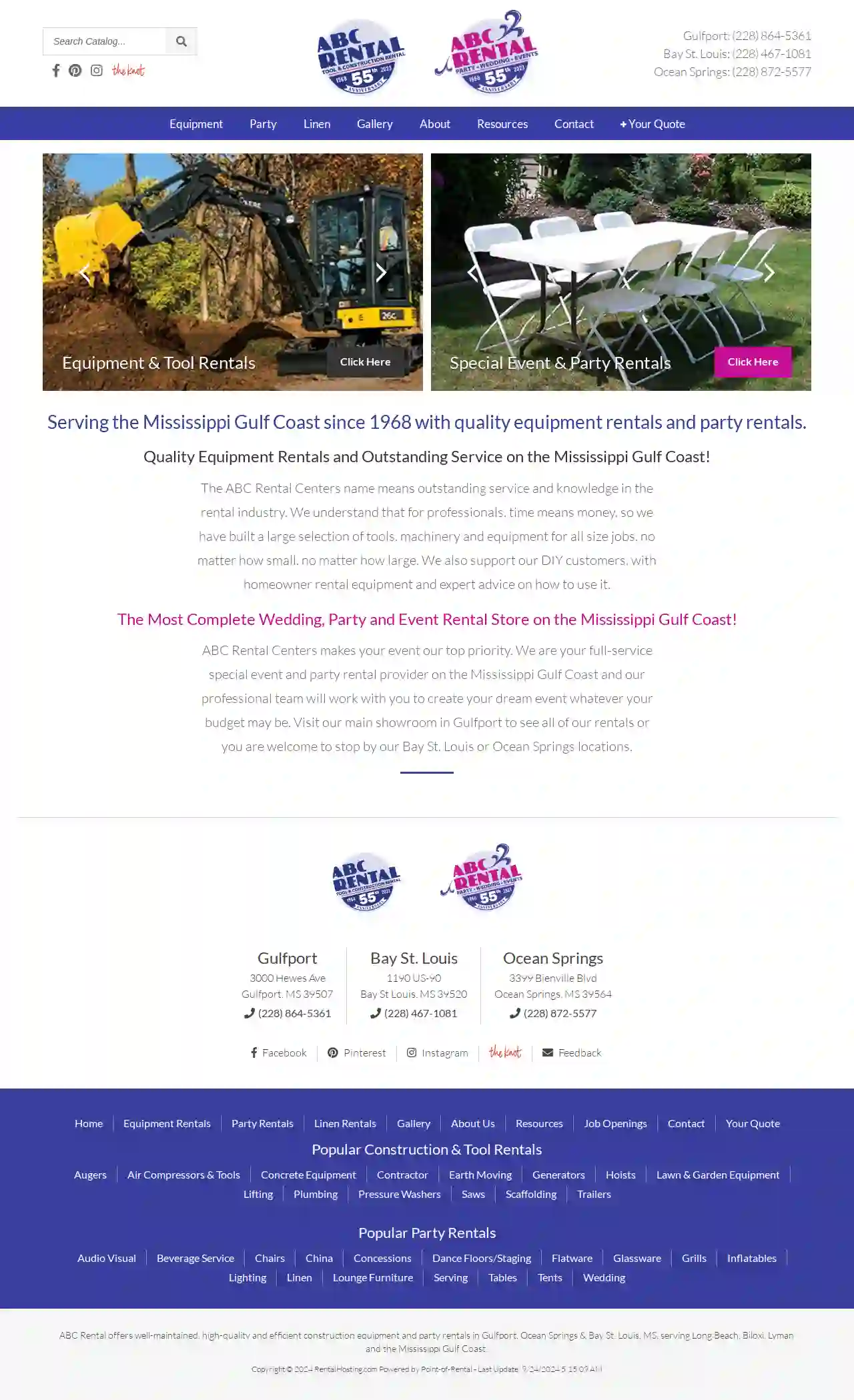Scaffolding Companies Bay St. Louis
Find the best Scaffold Services in Bay St. Louis
Receive up to 3 Scaffolding Company quotes for your project today! Compare profiles, reviews, accreditations, portfolio, etc... and choose the best deal.
Service Needed
City or Town

ABC Rental Center
4.4151 reviews3000 Hewes Ave, Gulfport, 39507, USABC Rental offers well-maintained, high-quality and efficient construction equipment and party rentals in Gulfport, Ocean Springs & Bay St. Louis, MS, serving Long Beach, Biloxi, Lyman and the Mississippi Gulf Coast. With a wide range of equipment and party rentals, ABC Rental is dedicated to providing outstanding service and knowledge in the rental industry.
- Services
- Why Us?
- Gallery
Get Quote- Ma
Magnolia Masonry of South Mississippi LLC
4.914 reviewsGulfport, US- Services
- Why Us?
Get Quote - Th
The Home Depot
4.2Gulfport, US- Services
- Why Us?
Get Quote - Lo
Lowe's Home Improvement
4.1Gulfport, US- Services
- Why Us?
Get Quote - Cr
Crom Equipment Rentals Inc
Gulfport, US- Services
- Why Us?
Get Quote
Over 2,353+ Scaffolding Companies in our network
Our scaffolding contractors operate in Bay St. Louis & surrounding areas!
ScaffoldingHQ has curated and vetted Top Scaffolding Businesses near Bay St. Louis. Find a reliable contractor today.
Frequently Asked Questions About Scaffolding Companies
Find answers to common questions about scaffolding companies and hiring scaffolding contractors in the USA.
- Steel: The most common material due to its strength, durability, and resistance to corrosion.
- Aluminum: Lighter than steel, often used for smaller projects or where weight is a concern.
- Timber: Used for decking platforms and some traditional scaffolding structures. It's less common now due to its susceptibility to rot and damage.
- Fiberglass: Used in specialized applications where electrical conductivity is a concern.
- Mobile Elevated Work Platforms (MEWPs): Scissor lifts, boom lifts, and other MEWPs offer flexible access for specific tasks.
- Mast Climbing Work Platforms (MCWPs): Ideal for high-rise construction, providing a stable working platform that can be raised incrementally.
- Suspended Access Equipment: Ropes and harnesses used for specific tasks like window cleaning or façade repairs.
- Ladders and Step Ladders: For shorter durations and limited working heights, provided they are used safely and appropriately.
- Project Height and Access: The height of the structure and the accessibility of the working area are primary considerations.
- Load Capacity: The weight of workers, materials, and equipment that the scaffolding needs to support.
- Project Complexity and Shape: The shape and complexity of the structure may necessitate specialized scaffolding configurations.
- Ground Conditions: The type of ground (soft, uneven, sloping) will influence the scaffolding foundation and support requirements.
- Duration of Use: The length of time the scaffolding will be needed can impact the choice of system.
- Budget: Different scaffolding types have varying costs.
- Workers: Consider the number of workers on the scaffolding at any given time.
- Materials: Include the weight of building materials, tools, and equipment being used on the platform.
- Environmental Factors: Factor in potential loads from wind or snow, especially for taller scaffolding structures.
What are some common materials used in scaffolding?
Scaffolding is typically constructed from durable materials:
What are some alternatives to traditional scaffolding?
Depending on the project, these alternatives may be suitable:
How do I choose the right type of scaffolding for my project?
Selecting the correct scaffolding depends on your project's specific requirements:
What is the weight limit for scaffolding?
The weight limit for scaffolding varies depending on the type of scaffolding, its design, and the materials used. The scaffolding should have a load capacity that safely accommodates the combined weight of:
What are some common materials used in scaffolding?
Scaffolding is typically constructed from durable materials:
- Steel: The most common material due to its strength, durability, and resistance to corrosion.
- Aluminum: Lighter than steel, often used for smaller projects or where weight is a concern.
- Timber: Used for decking platforms and some traditional scaffolding structures. It's less common now due to its susceptibility to rot and damage.
- Fiberglass: Used in specialized applications where electrical conductivity is a concern.
What are some alternatives to traditional scaffolding?
Depending on the project, these alternatives may be suitable:
- Mobile Elevated Work Platforms (MEWPs): Scissor lifts, boom lifts, and other MEWPs offer flexible access for specific tasks.
- Mast Climbing Work Platforms (MCWPs): Ideal for high-rise construction, providing a stable working platform that can be raised incrementally.
- Suspended Access Equipment: Ropes and harnesses used for specific tasks like window cleaning or façade repairs.
- Ladders and Step Ladders: For shorter durations and limited working heights, provided they are used safely and appropriately.
How do I choose the right type of scaffolding for my project?
Selecting the correct scaffolding depends on your project's specific requirements:
- Project Height and Access: The height of the structure and the accessibility of the working area are primary considerations.
- Load Capacity: The weight of workers, materials, and equipment that the scaffolding needs to support.
- Project Complexity and Shape: The shape and complexity of the structure may necessitate specialized scaffolding configurations.
- Ground Conditions: The type of ground (soft, uneven, sloping) will influence the scaffolding foundation and support requirements.
- Duration of Use: The length of time the scaffolding will be needed can impact the choice of system.
- Budget: Different scaffolding types have varying costs.
What is the weight limit for scaffolding?
The weight limit for scaffolding varies depending on the type of scaffolding, its design, and the materials used. The scaffolding should have a load capacity that safely accommodates the combined weight of:
- Workers: Consider the number of workers on the scaffolding at any given time.
- Materials: Include the weight of building materials, tools, and equipment being used on the platform.
- Environmental Factors: Factor in potential loads from wind or snow, especially for taller scaffolding structures.